Thursday, November 30, 2023. Annette’s News Roundup.
I think the Roundup makes people feel not so alone.
To read an article excerpted in this Roundup, click on its blue title. Each “blue” article is hyperlinked so you can read the whole article.
Please feel free to share.
Invite at least one other person to subscribe today! https://buttondown.email/AnnettesNewsRoundup
______________________________
Joe is always busy.
The GOP’s Impeachment Efforts against the President.
Representative Lisa McClain (R-MI), who sits on the House Oversight Committee that is out front on the impeachment effort, admitted on Fox Business that the committee has found no evidence that President Biden changed any policies after what Republicans claim was a bribe from China.
Hunter Biden.
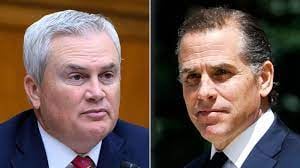
Also on Tuesday, the lawyer for the president’s 53-year-old son Hunter responded to a subpoena from Representative James Comer (R-KY), chair of the Oversight Committee, for Hunter Biden’s testimony in what Republicans insist is business corruption (there is no evidence of such wrongdoing by either Hunter Biden or his father).
Hunter Biden agreed to testify before the House Oversight Committee, saying he would do so in a public hearing, not in the closed-door session the House Republicans wanted.
“We have seen you use closed-door sessions to manipulate, even distort the facts and mislead the public,” Biden’s lawyer wrote.
When Biden’s former business partner Devon Archer was deposed by the Committee in July in closed-door session, Chairman James Comer (R-KY) did not even attend but nonetheless went on television to misrepresent Archer’s denial that Hunter Biden’s father was involved in the men’s business. “If, as you claim, your efforts are important and involve issues that Americans should know about, then let the light shine on these proceedings,” the lawyer wrote.
Comer, whose previous hearings have tended to blow up in his face as well-prepared Democrats tear into the Republicans, rejected the idea of holding a hearing in public.
“Let me get this straight,” Representative Jamie Raskin (D-MD), the top Democrat on the committee, said. “After wailing and moaning for ten months about Hunter Biden and alluding to some vast unproven family conspiracy, after sending Hunter Biden a subpoena to appear and testify, Chairman Comer and the Oversight Republicans now reject his offer to appear before the full Committee and the eyes of the world and to answer any questions that they pose? What an epic humiliation for our colleagues and what a frank confession that they are simply not interested in the facts and have no confidence in their own case or the ability of their own Members to pursue it.
“After the miserable failure of their impeachment hearing in September, Chairman Comer has now apparently decided to avoid all Committee hearings where the public can actually see for itself the logical, rhetorical and factual contortions they have tied themselves up in,” Raskin said. “The evidence has shown time and again President Biden has committed no wrongdoing, much less an impeachable offense. Chairman Comer’s insistence that Hunter Biden’s interview should happen behind closed doors proves it once again. What the Republicans fear most is sunlight and the truth.”
______________________________
Kamala is always busy.
Vice President Harris to Stand In for President Biden at U.N. Climate Conference.
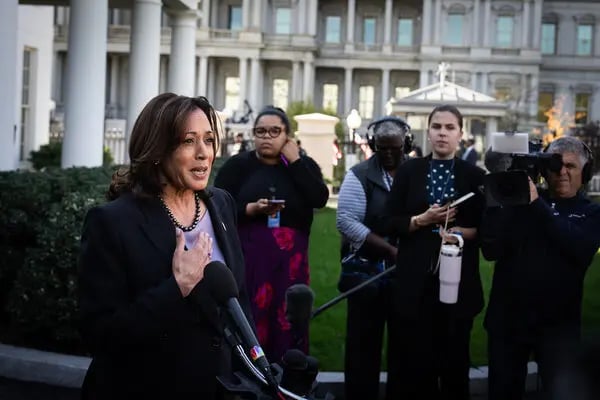
Officials said Vice President Kamala Harris would be joined in Dubai by three of the top climate officials in the United States, including John F. Kerry, the special presidential envoy for climate.
The president attended the annual conference in 2021 and 2022, but officials say this year he is preoccupied with the wars in the Middle East and in Ukraine.
Vice President Kamala Harris will attend the annual United Nations climate summit in Dubai on Friday and Saturday, standing in for President Biden, who will skip the event for the first time since taking office.
A spokeswoman for Ms. Harris said in a statement on Wednesday that while at the summit, known as COP28, the vice president would “underscore the Biden-Harris administration’s success in delivering on the most ambitious climate agenda in history, both at home and abroad.”
But her presence is unlikely to satisfy some climate activists, who have said that Mr. Biden’s decision to skip the summit — which is being attended by nearly 200 leaders from around the world — will undermine international efforts to confront the planet’s changing climate.
White House officials have said Mr. Biden is consumed with other global issues, including the war between Israel and Hamas and securing funding for Ukraine in its fight against Russia’s invasion, which has become the subject of an intense congressional clash in recent days.
Mr. Biden attended the climate summits in 2021 and 2022, setting the expectation among some climate activists in the United States that he would not miss it this year.
Officials said Ms. Harris would be joined in Dubai by three of the top climate officials in the United States: John F. Kerry, the special presidential envoy for climate; Ali Zaidi, the president’s national climate adviser; and John Podesta, the president’s senior adviser for clean energy innovation and implementation.
During the summit, officials said, Ms. Harris will announce several U.S. initiatives related to bolstering climate resilience in other countries and reducing greenhouse gas emissions. They said she would also discuss the passage of clean energy legislation during the first two years of the administration.
As vice president, Ms. Harris cast the tiebreaking vote on the Inflation Reduction Act, which provides $370 billion in government subsidies for solar panels, electric cars and other technologies designed to reduce emissions. The administration calls it the largest climate change investment by any country.
The White House did not provide a schedule for Ms. Harris at the summit, and did not say whether she would deliver a speech or hold a news conference while there.
In her statement, Kirsten Allen, the vice president’s press secretary, said Ms. Harris would engage with other leaders at the summit.
“The vice president’s participation in COP28 will continue the Biden-Harris administration’s leadership on bold, global action to address the climate crisis, advance U.S. climate goals, and help ensure a strong outcome at COP28,” she wrote. (New York Times).
______________________________
Congresswoman Lauren Boebert (R-CO) met her match when Joe Biden took action.
BREAKING: President Biden will be in Lauren Boebert’s district today to tout the legislation he passed, including the Bipartisan Infrastructure Law, the Inflation Reduction Act and the CHIPS and Science Act. Biden is reminding voters that Boebert voted against all of the above.
— Biden’s Wins (@BidensWins) November 29, 2023
______________________________
Nepal registers its historic first same-sex marriage - LGBTQ Nation.
https://www.lgbtqnation.com/2023/11/nepal-registers-its-historic-first-same-sex-marriage/

Nepal has registered its first same-sex marriage after years of legal wrangling. It is the first South Asian country to recognize a same-sex marriage.
Maya Gurung, a transgender woman, and Surendra Pandey, a gay man, were wed in 1997 in a traditional Hindu ceremony but were unable to have their marriage recognized by the government. Under Nepalese law, transgender women are unable to change their gender.
The country’s constitution, adopted in 2015, forbids discrimination based on sexual orientation.
In 2007, the country’s Supreme Court ordered the government to form a committee to prepare a law legalizing same-sex marriage. That committee recommended that the government “grant legal recognition to same-sex marriage on the basis of the principle of equality” in 2015.
Earlier this year, Nepal’s supreme court ordered the government to recognize the German same-sex spouse of a Nepali national. The couple, Adheep Pokhrel and Tobias Volz, were married in Germany, where same-sex marriage is legal, in 2018 but were denied a non-tourist visa for Volz by Nepali authorities. Pokhrel and Volz took their case all the way to the Supreme Court, citing a 2017 decision granting a non-tourist visa to Leslie Luin Melnik, the American wife of a Nepali lesbian, Suman Panta, as well as the court’s 2007 order.
In July, the court issued an interim order to allow same-sex couples and other LGBTQ+ couples to legally register their marriages while the government prepares legislation to amend the civil code and formally legalize same-sex marriage.
In July, the court issued an interim order to allow same-sex couples and other LGBTQ+ couples to legally register their marriages while the government prepares legislation to amend the civil code and formally legalize same-sex marriage.
In 2007, the country’s Supreme Court ordered the government to form a committee to prepare a law legalizing same-sex marriage. That committee recommended that the government “grant legal recognition to same-sex marriage on the basis of the principle of equality” in 2015.
Earlier this year, Nepal’s supreme court ordered the government to recognize the German same-sex spouse of a Nepali national. The couple, Adheep Pokhrel and Tobias Volz, were married in Germany, where same-sex marriage is legal, in 2018 but were denied a non-tourist visa for Volz by Nepali authorities. Pokhrel and Volz took their case all the way to the Supreme Court, citing a 2017 decision granting a non-tourist visa to Leslie Luin Melnik, the American wife of a Nepali lesbian, Suman Panta, as well as the court’s 2007 order.
In July, the court issued an interim order to allow same-sex couples and other LGBTQ+ couples to legally register their marriages while the government prepares legislation to amend the civil code and formally legalize same-sex marriage.
But officials had refused to recognize Gurung and Pandey’s marriage, citing a lack of clear instructions. The couple filed cases with the Kathmandu District Court and High Court, but their suits were rejected. But a change to the regulations at the Home Ministry this week allowed officials to move forward with the recognition process.
“After 23 years of struggle, we got this historic achievement, and finally Maya and Surendra got their marriage registered at the local administration office,” Sunil Babu Pant, a gay former parliamentarian and LGBTQ+ activist, said. (LGBTQ Nation).
______________________________
Mike Pence is no hero but his January 6th behavior was worse than we knew.
The plot thickens on a Mike Pence Jan. 6 refusal.
November 28, 2023 at 1:17 p.m. One of the least examined X factors in the Jan. 6 saga is this: the possibility that Vice President Mike Pence might have recused himself from the counting of electoral votes in Congress. Given that Pence ultimately played a decisive role in thwarting Donald Trump’s attempts to overturn the election that day, and that some in Trump’s orbit apparently gamed out and even desired Pence’s recusal, it is valid to ask what might have happened if he had not been at the Capitol on Jan. 6, 2021.
We apparently came closer to finding out than we realized. ABC News reported Tuesday that on Christmas Eve 2020, Pence momentarily decided against presiding, in part since it would be “too hurtful to my friend.” ABC also reported that Pence testified that Trump personally suggested he recuse himself. (The Washington Post has not independently confirmed the reporting.)
“Not feeling like I should attend electoral count,” Pence wrote in notes obtained by special counsel Jack Smith, according to ABC. “Too many questions, too many doubts, too hurtful to my friend. Therefore I’m not going to participate in certification of election.
” Pence testified that he reversed course after a conversation with his son, who cited the vice president’s constitutional duty, according to ABC.
The date of that conversation is not clear, but it came at some point during a trip that Pence took to Colorado, which records indicate lasted from Dec. 23 to Jan. 1.
It is the first evidence that Pence had actually leaned toward recusing himself, and that Trump had personally suggested it. But it is hardly the first evidence that it was under consideration and that certain people on Trump’s side had angled for it. We previously detailed the publicly available evidence on this episode, some of which has not received much attention. Here is how the new disclosures fit into the timeline: Unknown date: Trump suggests Pence might skip the Jan. 6 session of Congress, according to the ABC report on his testimony.
Early December: Pence and his legal counsel, Greg Jacob, discuss potential recusal and whether Pence has a conflict of interest, according to testimony by Jacob before the Jan. 6 committee. Jacob said Pence asked, “Has any vice president ever recused from the role of doing this on the grounds that they are interested in the outcome of the election?” Pence’s staff later reports back that Hubert Humphrey sat out such proceedings in 1969, leaving the job to the Senate president pro tempore.
Dec. 13: Trump lawyer Kenneth Chesebro in a memo floats a detailed scenario in which Pence steps aside. The scenario cites Senate president pro tempore “Chuck Grassley or another senior Republican who agrees to take on the role of defending the constitutional prerogatives of the President of the Senate.”
Dec. 23: Trump lawyer John Eastman writes an email to Chesebro and others that references not wanting to “constrain Pence (or Grassley) in the exercise of power they have under the 12th Amendment.”
“Not feeling like I should attend electoral count,” Pence wrote in notes obtained by special counsel Jack Smith, according to ABC. “Too many questions, too many doubts, too hurtful to my friend. Therefore I’m not going to participate in certification of election.”
Pence testified that he reversed course after a conversation with his son, who cited the vice president’s constitutional duty, according to ABC. The date of that conversation is not clear, but it came at some point during a trip that Pence took to Colorado, which records indicate lasted from Dec. 23 to Jan. 1.
It is the first evidence that Pence had actually leaned toward recusing himself, and that Trump had personally suggested it. But it is hardly the first evidence that it was under consideration and that certain people on Trump’s side had angled for it. We previously detailed the publicly available evidence on this episode, some of which has not received much attention. Here is how the new disclosures fit into the timeline:
Unknown date: Trump suggests Pence might skip the Jan. 6 session of Congress, according to the ABC report on his testimony.
Early December: Pence and his legal counsel, Greg Jacob, discuss potential recusal and whether Pence has a conflict of interest, according to testimony by Jacob before the Jan. 6 committee. Jacob said Pence asked, “Has any vice president ever recused from the role of doing this on the grounds that they are interested in the outcome of the election?” Pence’s staff later reports back that Hubert Humphrey sat out such proceedings in 1969, leaving the job to the Senate president pro tempore.
Dec. 13: Trump lawyer Kenneth Chesebro in a memo floats a detailed scenario in which Pence steps aside. The scenario cites Senate president pro tempore “Chuck Grassley or another senior Republican who agrees to take on the role of defending the constitutional prerogatives of the President of the Senate.”
Dec. 23: Trump lawyer John Eastman writes an email to Chesebro and others that references not wanting to “constrain Pence (or Grassley) in the exercise of power they have under the 12th Amendment.”
Dec. 23: A Grassley aide emails a Pence aide asking if there is “any reason to believe that your boss will not preside over the electoral college vote count,” according to the Jan. 6 committee transcripts. Pence aide Paul Teller says that “it’s not a zero percent chance of that happening.”
Dec. 24: Pence concludes he will not preside, according to his notes, ABC reported.
Sometime by Jan. 1: Pence’s son, a Marine, persuades him to preside, citing the oaths they both took to support and defend the Constitution, according to ABC.
Jan. 5: Grassley sets off a brief tempest by telling the media, “If the vice president isn’t there, and we don’t expect him to be there, I will be presiding over the Senate.” A news report initially casts this as Grassley saying that Pence will be absent from the electoral college certification, but his actual comments appeared to refer to a separate session of the Senate, which his office swiftly clarified.
It is worth noting that what may have been a (momentary) decision by Pence came just after a Grassley aide reached out to his office about such a scenario and the Pence aide suggested it was on the table. So this was a possibility that plenty of people had been thinking and talking about.
For the better part of three years, those Grassley comments on Jan. 5 have spawned theories about how he might have been part of the plot. The new details in the timeline, as laid out by ABC, do not indicate that Grassley was in on anything, and he has flatly denied that he was. (Grassley and his office have denied ever being approached about such an arrangement.) In fact, both that timeline and the testimony of top Pence aides suggest this was off the table well before Jan. 5.
But a growing volume of evidence indicates that, at least at some point, a Pence recusal was a real possibility. The question is why. Thus far there are no definitive answers, but there are clues. Grassley, like many Republicans, kept relatively quiet after the election. He was not a vocal election denier. He noted that the process should be allowed to play out. He said shortly after the election that “there could be fraud” but that “I personally haven’t seen any” that would be enough to change the results.
But at times Grassley suggested the election was effectively over. On Nov. 9, his office told a local editorial board “it appears Joe Biden will be the next president.” A few days later, he pushed for Biden to receive classified briefings in preparation for his ascension. When the electoral college voted Dec. 14, Grassley was asked whether he acknowledged that Biden was president-elect, and he said, “I don’t have to. The Constitution does.” His office would go on to call Biden the “president-elect” in a Dec. 22 statement.
Grassley did not join the handful of Senate Republicans (and many House Republicans) in objecting to the election results on Jan. 6. And after the Capitol riot, he praised Pence for refusing to “kowtow” to Trump’s entreaties to overturn the election. In other words, Grassley would have seemed a less-than-ideal candidate for taking the unprecedented step of trying to overturn the election, a step that Pence ultimately refused to take.
At least for now, the reason some people angled for Grassley to replace Pence appears to boil down to the fact that Pence was not fully onboard and that Grassley was next in line. Another possible reason is that substituting Grassley and having him help overturn the results might have looked like less of a conflict of interest than it would have for Pence, who would effectively have been reinstalling himself as vice president.
Chesebro wrote in a Dec. 13 memo that “politically this will insulate” Pence “and the President from what will happen next. For it is much easier for someone acting as President of the Senate to defend the prerogatives of the office if he has no conflict of interest” other than an unavoidable partisan interest.
There is still little reason to believe the plan to have Pence removed from the equation would have resulted in a different outcome. But as we learn more, it gets clearer this was a desired variable on Trump’s side and that Trump’s demand for personal loyalty almost led us down a different, and unpredictable, path at a consequential time. ( Washington Post).

______________________________
Republican Speaker Mike Johnson has 'real reservations' about expelling George Santos but we have a chance. Soon.
303 House members, including 90 Republicans and 213 Democrats, intend to vote for George Santos' expulsion, exceeding the required two-thirds majority with 69.66%. pic.twitter.com/SeINMZgjPh
— Brian Allen (@allenanalysis) November 29, 2023
Rep. Pete Aguilar: "Do you think for a minute if Republicans had a 25-seat majority, they would care about George Santos' vote? They needed him to vote for Speaker McCarthy. They needed him to vote for Speaker Johnson. That's the only reason why he's still a member of Congress."
— Kyle Griffin (@kylegriffin1) November 29, 2023
______________________________
Hostages Released on Wednesday.
On Wednesday, 16 additional people - 10 Israelis and four Thai nationals - ,who had been held hostage in the Gaza Strip, were released, pushing the number of freed captives past 100, and in return Israel a few hours later set free 30 more Palestinian prisoners.
______________________________
A Candid Announcement.
Henry Kissinger, War Criminal Beloved by America’s Ruling Class, Finally Dies
— Rolling Stone (@RollingStone) November 30, 2023
More: https://t.co/6kaj57PyIQhttps://t.co/6kaj57PyIQ
______________________________
Let Us Tell You A Story
How Jewish people built the American theater as we know it.
https://www.nytimes.com/interactive/2023/11/29/t-magazine/jewish-theater-antisemitism-maestro.html?smid=nytcore-ios-share&referringSource=articleShare
HOW ARE THINGS in Glocca Morra?” is a song from the 1947 musical “Finian’s Rainbow,” which is about, among other things, a leprechaun. Glocca Morra doesn’t exist, and if it did, it wouldn’t be in, say, Poland. The song is sung by a homesick Irish lass in the American South; like the show overall, it is the most goyish thing that ever happened on Broadway, unless that would be “Brigadoon,” which opened the same year, with its highland heather and men in kilts. That one’s about a town that awakens only once every hundred years, also not in Poland.
Or is it? Like the score for “Brigadoon,” by Lerner and Loewe, the score for “Finian’s Rainbow” was written by two Jews: E.Y. Harburg (né Isidore Hochberg; the “Y” stood for “Yipsel”) and Burton Lane (né Burton Levy). The show was produced, stage managed and for the most part designed by Jews. The musical director, dance arranger and press reps were Jews. In a city then home to more than two million Jews — even now, the most Jewish city in the world, by sheer numbers — so were a lot of the ticket buyers. (Twenty years later, the playwright and screenwriter William Goldman estimated that Jews made up half the Broadway audience.) Did they hear something familiar in the tune of “Glocca Morra,” even as the lyrics, saluting “Killybegs, Kilkerry and Kildare,” denied it?
Of course, many gentiles also appreciated the yearning-for-a-simpler-time song, which reached deep into American culture in those postwar years. Along with several other tunes from the show — “Old Devil Moon,” “Look to the Rainbow,” “If This Isn’t Love” — “Glocca Morra” was a popular hit, covered by Sammy Davis Jr., Julie Andrews, Connie Francis, Rosemary Clooney, the Tommy Dorsey band and, over time, some hundred others. Davis, a convert, was the most Jewish among them.
Or he was until the song was sung, around 1967, at my temple. For the edification of our suburban Philadelphia congregation, the rabbi’s wife put on annual shows that spoofed Broadway hits with Jewish-themed puns. “How Are Things in Glocca Morra?” became “How Are Things in the Gemara?” — the Gemara being an ancient work of rabbinical commentary, and thus a boffo punchline in the synagogue stageatorium. “How Are Things in the Gemara?” was funny, it was lovely, it was filled with longing — and it was ours.
You couldn’t say that about most of what appeared on American stages in the 1940s, musical or otherwise, unless you knew the secret. Though Jews had been an integral part of mainstream theater for decades — creating, presenting, teaching and consuming it — and had found in it the ultimate and most enduring expression of their artistry, seldom was the product Jewish on the surface.
The same year that “Finian’s Rainbow” and “Brigadoon” opened on Broadway, Arthur Miller’s “All My Sons” did, too. A morality play about an airplane parts manufacturer whose corner cutting leads to the death of 21 airmen, it is virtually Talmudic in its exquisite weighing of individual and communal responsibility. Everything about it is Jewish except the characters.

This past summer, T invited dozens of Jewish actors, playwrights, songwriters and directors to join their collaborators and colleagues for a group portrait in New York, onstage at Broadway’s Lyceum Theater. When nearly 50 of them arrived on Sept. 11, 2023, it was all but impossible to get them to take their places as they sang songs, told jokes and shared stories of lives spent — together, joyously — in the theater.
Front row, from left: the comedian Alex Edelman, the director and writer Tina Landau, the actress Judy Kuhn, the composer Alan Menken, the composer and lyricist Benj Pasek, the director and playwright Moisés Kaufman and the director TripCullman. Second row, from left: the actress and writer Tavi Gevinson, the librettist John Weidman, the actress Jackie Hoffman, the playwright PaulaVogel, the actor Ethan Slater, the actress Julie Benko, the actor Chip Zien, the playwright and librettist Alfred Uhry, the actor Danny Burstein, the actor Steven Skybell, the actor and director Joel Grey, the actress Jessica Hecht, the actor Alex Brightman, the actress Leslie Rodriguez Kritzer, the composer and lyricist Marc Shaiman and the actress Carol Kane. Back row, from left: the playwright Tony Kushner, the actor and writer Jesse Eisenberg, the actor Liev Schreiber, the playwright Jon Robin Baitz, the director Leigh Silverman, the director Michael Mayer, the director Thomas Kail, the actress Idina Menzel, the actor Gideon Glick, the actor Brandon Uranowitz, the composer and lyricist Jason Robert Brown, the actor Josh Gad, the director Lila Neugebauer, the director Sam Gold, the playwright Amy Herzog, the playwright Joshua Harmon, the composer and lyricist Tom Kitt, the playwright Steven Levenson, the composer and lyricist Amanda Green, the actress Shoshana Bean, the actor and writer Harvey Fierstein, the actor Matthew Broderick and the actress Debra Messing.
Photograph by Jason Schmidt. Set design by Christine Jones
Nor is it a one-off. Like many Jewish playwrights of the period, Miller, barely a generation away from a Polish shtetl himself, erased the Jews if not the Jewishness from almost all his reputational works. The putatively gentile “Death of a Salesman,” which had its premiere two years after “All My Sons,” sounds to me, with its Yiddish cadence (“Take an aspirin. Should I get you an aspirin?”) and revolving arguments, like the fractious seders at my grandparents’ apartment. (I’ve never heard a non-Jew say “dast” for “dare” as the down-to-earth Charley does: “Nobody dast blame this man.”) And though “The Crucible” (1953) is set among Massachusetts Puritans and “A View From the Bridge” (1955) among Italian American dockworkers, they, too, feel rabbinical in their ethical wrangling. It wasn’t until the 1960s, with “After the Fall,” a fictionalized rehash of his relationship with Marilyn Monroe, and “Incident at Vichy,” a Holocaust drama, that Jews really showed up — unavoidably and somewhat self-consciously — in Miller’s plays.
By then they were showing up elsewhere, too, often in popular comedies and musicals that highbrow Jewish critics nevertheless despised. Robert Brustein called “Biloxi Blues,” among Neil Simon’s most Jewish works, “meretricious.” Cynthia Ozick described “Fiddler on the Roof,” the 1964 megahit based on Sholom Aleichem stories about impoverished Ukrainian Jews, as “romantic vulgarization” — and Philip Roth trumped her with “shtetl kitsch.” (Had either of them ever seen a musical before?) Miller could write Jewishly, but not about Jews; Simon could write about Jews, but not Jewishly. Damned either way, it seems, but no one said assimilation would be easy.
Well actually, in “Candide” (1956), Leonard Bernstein says just that. A character known as the Old Lady, passing herself off as Spanish though her father “spoke a High Middle Polish,” celebrates her chameleon skills in a song called “I Am Easily Assimilated.” The composer’s own lyrics: “These days, you have to be / In the majority.”
WHICH BRINGS US to the matter of Lenny’s nose, or rather Bradley Cooper’s embodiment of it in the Bernstein biopic “Maestro.”
Before the film’s release last month, Cooper’s prosthetic schnoz drew criticism from many Jews, alert to the re-emergence of a hateful caricature that had trailed them for centuries, often attached to actors. It wasn’t so long ago that gentiles playing Shylock in William Shakespeare’s “The Merchant of Venice” did so in “Jewface,” with a large and pendulous hook nose meant to telegraph animality and greed. (Shakespeare describes Shylock variously as a “wolf,” a “cur” and a “cutthroat dog.”) Whether the actor who originated the role in the 1590s wore a wax honker is unknown, but the stereotype was certainly familiar by then. In Christopher Marlowe’s nearly contemporaneous “The Jew of Malta,” the title character’s Moorish slave says, “Oh, brave master, I worship your nose for this.”
Even without the noses — and despite, in Shakespeare’s case, the mitigating poetry — both plays are viciously antisemitic. There’s a reason “The Merchant of Venice,” according to some historians, was the most produced Shakespeare play in Germany during the Third Reich. As the theater scholar Farah Karim-Cooper notes in her book “The Great White Bard” (2023), audiences are strongly influenced by disinformation onstage. In a 2010 study she cites, playgoers in Sweden, Germany and England were asked to evaluate the statement “The reason for antisemitism is the behavior of the Jews in history” both before and after seeing “Merchant.” One out of four found the statement “more correct” afterward. And Shylock was seen as a “typical” Jew by nearly a third.
That shouldn’t surprise us if we believe in the power of theater to confirm and even create opinions and feelings. Whether that power is used toward good ends or bad, the medium itself is unconcerned.


Cast members from Tom Stoppard’s “Leopoldstadt” (2020), which had its Broadway debut last year.
Jews do not have that luxury: The Anti-Defamation League reports that antisemitic incidents in the United States increased to record levels last year; disturbing comments from public figures seemed to increase even more. Yet if Cooper’s prosthesis is too silly a hill to stand on in that context, violence against Jews, whether verbal or physical — from Kanye West’s vitriol to the 2018 Tree of Life synagogue shooting in Pittsburgh to the recent terrorist attacks on Israeli civilians by Hamas — has often seemed too complex for artists, with their tendency toward both-sides-ism, to face. (What about free speech? What about Israel’s treatment of the Palestinians?) Especially in the theater, a supposed safe space for Jews, the response to historical, no less than imminent, threats has always been erratic and constrained.

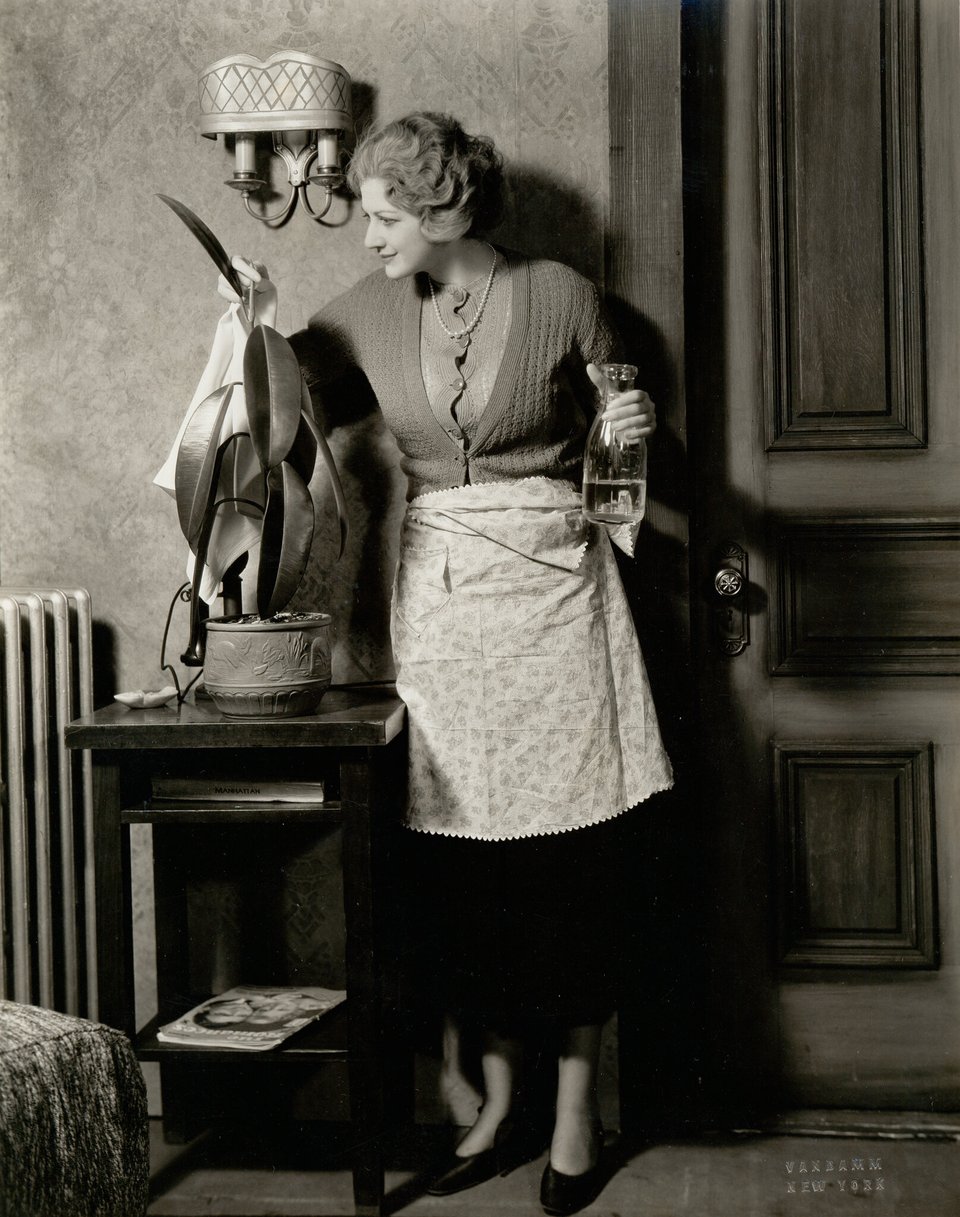

From top: a scene from S. Ansky’s “The Dybbuk” (written between 1913 and 1916) in a 1925 New York production; Stella Adler as Bessie Berger in Clifford Odets’s “Awake and Sing!” (1935); the playwright Arthur Miller (right) with the director Elia Kazan in 1949, the same year the pair collaborated on the original Broadway production of “Death of a Salesman.”
Not because of a lack of overtly Jewish content. Indeed, the irony is that more shows than ever, both premieres and revivals, seem to be dealing with antisemitism, at least in the past. That they rarely get to the heart of the issue — the sometimes self-imposed (and sometimes viciously enforced) invisibility of Jewishness — is the result of a fear of offense or habit of disguise that evolved as a kind of protection for Jews both onstage and off. Any Roth novel will teach you, as my own childhood taught me, that you must assimilate to a certain degree to survive in an antisemitic world; I stopped talking about “Fiddler” when classmates started calling me “kike.” Yet assimilate too much and something integral to your nature dissolves; for me it would have been like killing my grandparents, as they often made sure to tell me.
Waffling over the expression of identity is probably inherent to all American minority experiences, but it is especially central to, and problematic for, Jewish art, which is often specifically about that waffling and takes its argumentative shape from it, too. But if this “see me/don’t see me” dichotomy has roots as deep as the history of Jews in the American theater, reflecting the age-old conflict of writing for everyone while still being seen for yourself, it was nonetheless shocking to hear, in 2023, what one Broadway insider told me: “Mostly we keep quiet because if we talk, they ship us on the trains.”
This fear persists even though, as I’ve said, New York City stages have in the past year offered a bumper crop of plays and musicals that speak to the subject of antisemitism. Tom Stoppard’s semi-autobiographical “Leopoldstadt” dramatizes the results of the Nazi Anschluss on a Viennese Jewish family in the 1930s and after. “The Doctor,” a revamp of a 1912 Arthur Schnitzler play, starred Juliet Stevenson as Ruth Wolff, a prominent Jewish physician canceled by anti-Semites. The best scenes in the revival of “The Sign in Sidney Brustein’s Window,” Lorraine Hansberry’s 1964 takedown of a hypocritical Greenwich Village Jew, feature Sidney’s casually antisemitic sister-in-law. The comedian Alex Edelman’s “Just for Us” recounts his infiltration of a white supremacist group in a misguided attempt at “outreach.” And things really went meta at the first preview of “Parade,” a revival of the 1998 musical about Leo Frank, the New York Jew lynched in Georgia in 1915. Outside the Bernard B. Jacobs Theater, around a dozen protesters representing the Empire State Stormers (a neo-Nazi group affiliated with the so-called Goyim Defense League) yelled at playgoers and distributed fliers attacking Frank as a “Jewish child-murdering pedophile.”
Even so, the most pointed onstage treatment of antisemitism, connecting it to the nature of allyship and lip service within the theater itself, may have been the one that turned the subject into a joke. In “Gutenberg! The Musical!” — a satire in the guise of a backers’ audition for a horrible show about the inventor of the printing press — two aspiring Broadway writers pause their opening patter to announce somberly that since “every important musical has to tackle at least one incredibly serious issue,” theirs will be antisemitism. That’s the last you hear of it, except when a character called Antisemitic Flower Girl occasionally barks things like “I hate Jews” to big audience guffaws.
Gutenberg! The Musical!” opened a few days after the Hamas attacks and, in the wake of the terrifying news, some Jewish actors, producers and writers began to feel that the real Broadway wasn’t doing much more than the satirical one in “Gutenberg.” Where was the clear response from their non-Jewish colleagues? Having rightly been asked to educate themselves and speak out about threats to other communities, Jews worried in anxious, private conversations why the same education and outspokenness seemed absent when it came to them. “When it’s time to say, ‘Are you here for us?’” one told me, “I fear that they are not.”
In these conversations, some Jews also wondered if they were partly responsible for the failure of others to see them as a marginalized group — or to see them at all. Had Jewish creatives participated in, and in essence condoned, the sidelining of Jewishness on Broadway, a street they basically built? Two of the three fine actors who starred in 2021 in “The Lehman Trilogy” — a multigenerational epic about the Jewish banking family — were gentiles. So is Oscar Isaac, the Sidney in “Sidney Brustein.” (Well, Isaac has some Jewish heritage on his father’s side, hence the “Isaac.”) Both shows were directed by Jews. Stevenson, who played Ruth Wolff in “The Doctor,” would not say what if any faith she practiced. (Nor would that show’s director, Robert Icke.) This list goes on, and is even more striking in film and television, well beyond the Roman Catholic Cooper. In casting Rachel Brosnahan as the title character on “The Marvelous Mrs. Maisel” — a comedian obviously modeled on the assertively Jewish Joan Rivers — its producers achieved a difficult double de-Jewification. (On Broadway, though, Brosnahan played Sidney Brustein’s gentile wife.) And did you ever see the nasal monstrosity that Alec Guinness (also Roman Catholic) wears as Fagin in the 1948 film “Oliver Twist,” three years after the liberation of Auschwitz? Where was his impeccable timing then?
As a critic, I’m supposed to be agnostic about such matters; if someone’s good, they’re good. Cooper, a graduate of the Actors Studio, is excellent and, if the nose helped him get there, nobody dast blame the man for that.
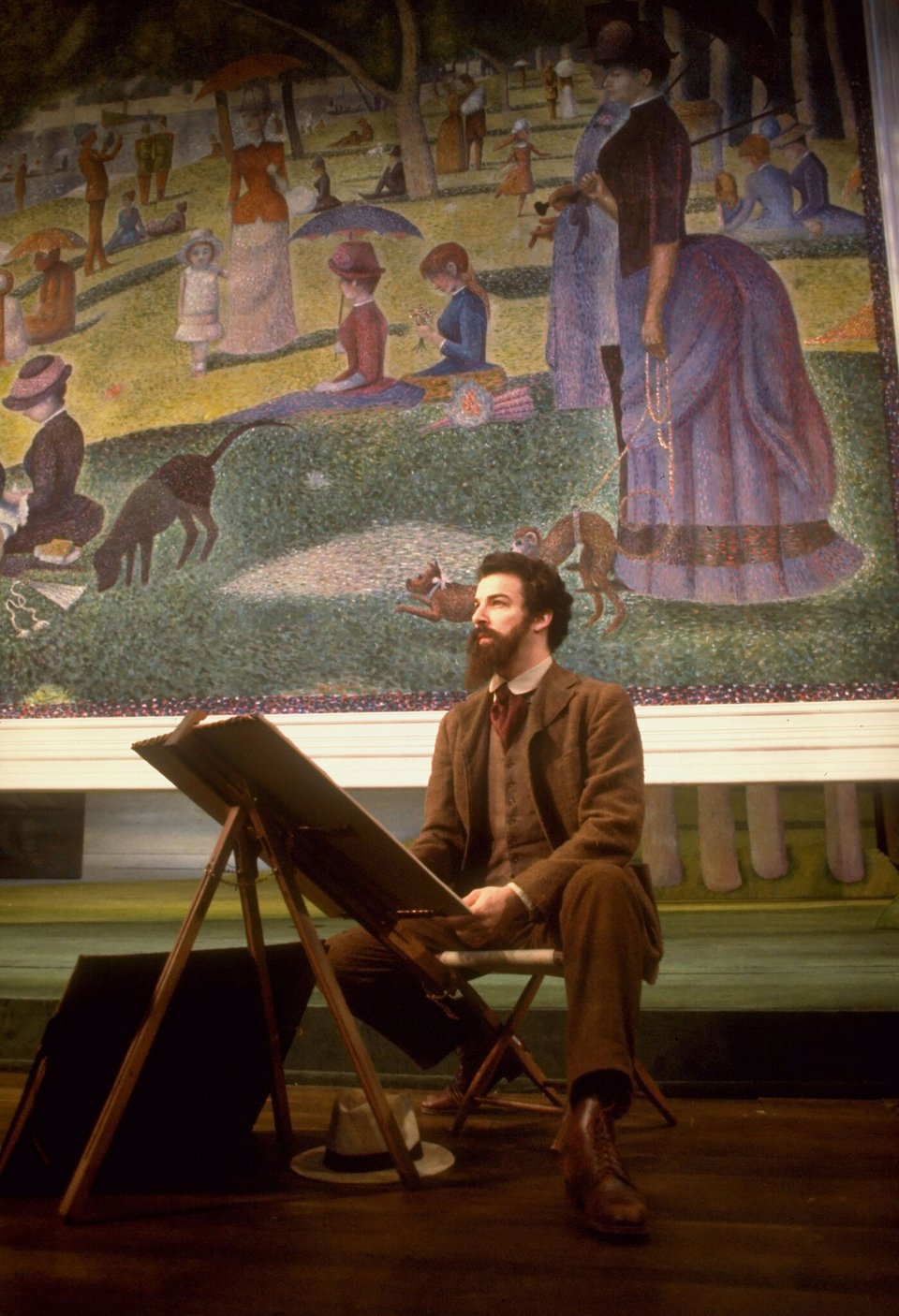
Mandy Patinkin takes the lead in the original 1984 Broadway production of James Lapine and Stephen Sondheim’s “Sunday in the Park With George.”

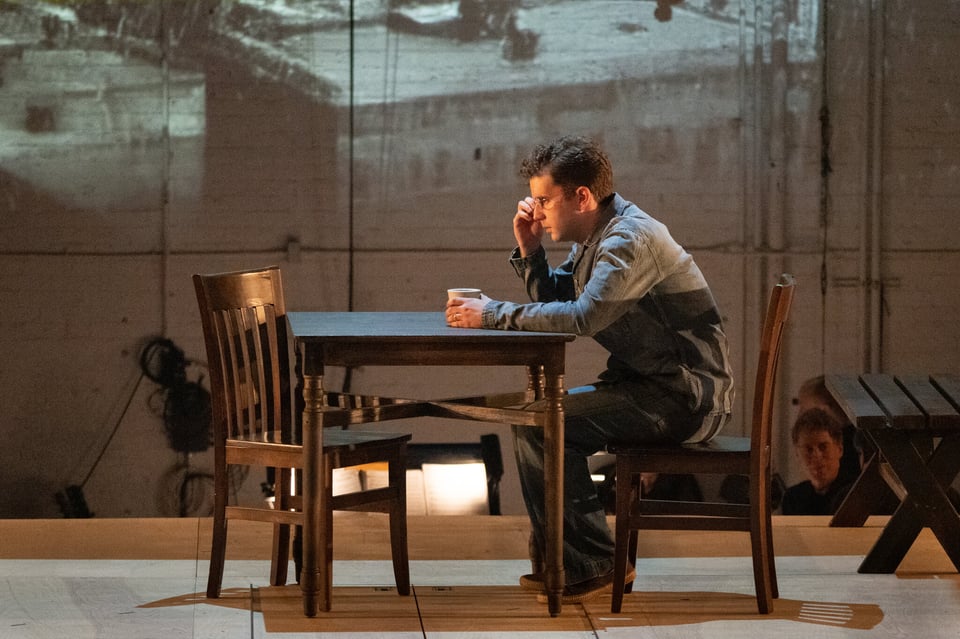
Micaela Diamond (left) and Ben Platt as the embattled Atlanta Jews Lucille and Leo Frank in last year’s Off Broadway revival of Alfred Uhry and Jason Robert Brown’s “Parade” (1998).
But as a coreligionist of Bernstein and Miller and Simon and Rivers and Wolff and the Lehmans, as well as of the Brusteins both Robert and Sidney, I find myself forced, after a season that kept foisting ideas of doomed Jewishness on us — and with a new season continuing to do so with the Holocaust-themed “Harmony,” “Prayer for the French Republic” and “Cabaret” — to question that agnosticism. Who, after all, is all this trauma for? Must the cultural place for endangered minorities always be reduced to their danger only? I have seen too many plays use the Holocaust as a dramatic accelerant or a free pass to pathos.
Jews already know their trauma too well. Others seem to enjoy it or, worse, think of it as a moral vitamin. And though I’m not categorically opposed to the educational function of theater, what troubles me is what isn’t getting said. The theater, which for many Jews was a major way of becoming American in the first place, seems unable to acknowledge that the danger that American Jews face is not just historical, and not just onstage.
“Have we assimilated too much for people to even see us?” one Broadway producer asked me in the week after the Hamas attacks.
I, too, can’t help thinking about the mixed blessing of assimilation, both a goal and a trap. How is it that Jews, in successive waves and for different reasons, keep getting erased from the theatrical culture they did so much to create? Stranger still, they often seem to be holding the eraser — and the scalpel. The nose Cooper put on is the one Jews have spent a century taking off.
IN 1923, LEE Strasberg, a 21-year-old New York City high school dropout with an interest in theater but a job as a bookkeeper in a wigmaker’s shop, saw Konstantin Stanislavsky’s Moscow Art Theater perform at Jolson’s Fifty-Ninth Street Theater.
Known for its emphasis on the inner life of characters and the rigorous discipline demanded of actors to reproduce it, the Russian troupe, founded in 1898, was presenting six plays in repertory, including “The Lower Depths,” “The Three Sisters” and “Tsar Fyodor Ivanovich.” Grim stuff, but the dropout, Strasberg, sat rapt at every performance.
Though the plays were performed in Russian, a language Strasberg didn’t understand, the subtle artistry of the actors — so different from the operatic histrionics typical of the time — seemed to reach out from the stage and offer a lifeline. His had not been a particularly happy or fulfilling life to date. Born Israel Strassberg on a Polish shtetl, and known by the diminutive Srulke, he came to America in 1909 and lived meanly with his family on the Lower East Side. The death of his beloved older brother Zalmon during the influenza pandemic of 1918 nearly undid him; it was Zalmon who had encouraged his interest in Yiddish culture. Srulke performed in local Yiddish-language productions, saw professional plays when he could and embarked on a course of his own wide reading. But the realities of the stage did not match the ideals of his imagination until his encounter with the work of the man who, by any other standards, would have seemed his antipodal foil.
Stanislavsky, the Art Theater’s co-director and most famous teacher, was born in 1863 to a landed Christian family, manufacturers of gold and silver thread. His education was enriched by his access to great art and by his exposure to a semi-mystical Eastern Orthodox sect known as the Old Believers. So when later writing of the actor’s “soul” in his seminal mid-20th-century books “An Actor Prepares” and “Building a Character,” it was no metaphor for sensitivity. Rather, as the cultural historian and critic Isaac Butler told me, Stanislavsky believed that people who aspired to work in the theater “were called to a literally holy task.”
How an ideal of acting proposed by a rich, cosmopolitan Christian came to be interpreted, promoted and glorified in the United States primarily by poor, tenement-raised Jews is the mystery at the center of Butler’s book “The Method: How the Twentieth Century Learned to Act” (2022). Part of the answer, he says, is the “shall-we-say comfort with debate at sometimes very loud volumes” that is almost a Jewish article of faith. And part of it, at least in the case of Strasberg and his founding colleagues Harold Clurman and Stella Adler, was an “almost Talmudic level of scholarship.”
But bigger than both was the Yiddish theater: a keepsake of home, and yet also a means of acculturation for the 2.5 million Jews who arrived in the United States between 1881 and 1924. The tradition of popular drama (and especially comedy) was one of the few forms of cultural expression they could bring with them on boats besides their recipes and religion. And if in the old country the Yiddish theater looked mostly inward, addressing its own communities, in the new country, especially in New York, where most Jews settled, it began to move outward, drawing even non-Yiddish-speaking audiences to a parallel Broadway along Second Avenue. In the district’s many theaters they might see the Yiddish shocker “The Dybbuk” (1920) or translations of the works of George Bernard Shaw and Henrik Ibsen that had not yet appeared in the city in English.
That was the world in which Strasberg, Clurman and Adler grew up. (Both of Adler’s parents were Yiddish theater stars — her father, Jacob Adler, was a renowned Shylock in 1903.) For them, the theater was a form that united intellectual rigor with expressive potential but also offered a path into the mainstream, or at least a louche branch of it. At a time when only a few industries (including banking and the garment trade) were open to Jews, it was a way for them to commodify their intelligence. The problem was that, with its pandering and bellowing, the Yiddish version was no longer enough.
Seeing the Moscow Art Theater perform in the early 1920s amounted to a conversion experience for all three; learning how actors could experience real feelings onstage, in detail and in depth, became their life’s goal.
But because, like most converts, they were zealots, it wasn’t just a conversion experience for them. Through their later roles as founders and leaders of the Group Theater, the Actors Studio and other schools and programs, they turned Stanislavsky’s system into the Method — and the Method into the prevailing style of American acting. Embedding their own observation and experience within Stanislavsky’s, along with the best of Yiddish theater and a generous dollop of Freud, they converted the American theater to Judaism.



Various productions of Joseph Stein, Sheldon Harnick and Jerry Bock’s “Fiddler on the Roof” (1964), including, from top, Bette Midler (center), who made her Broadway debut as Tzeitel in 1967, during the show’s first run; Jackie Hoffman as Yente in the 2018 Yiddish Off Broadway version; and the original 1964 Broadway version.
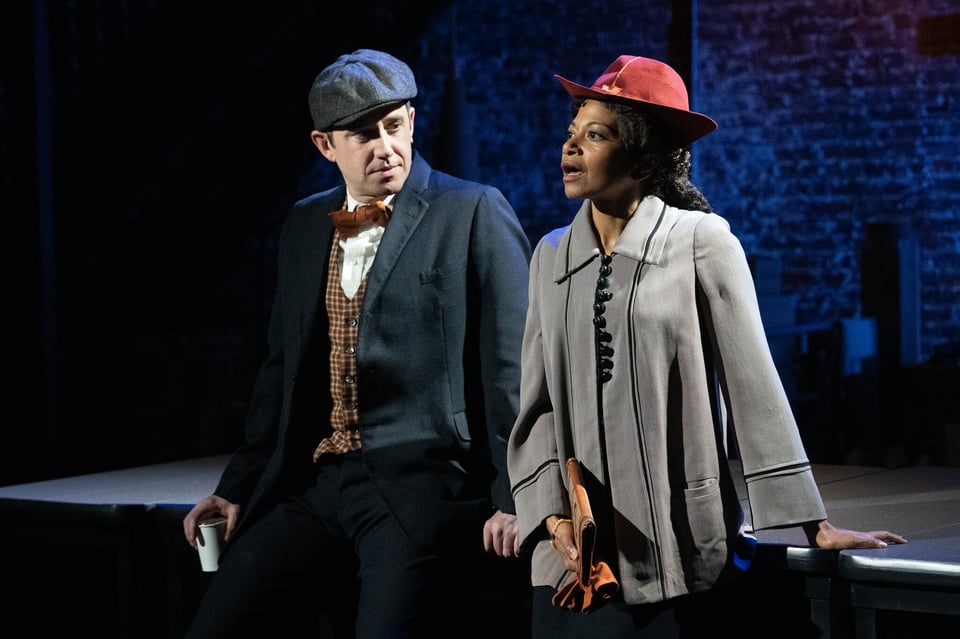
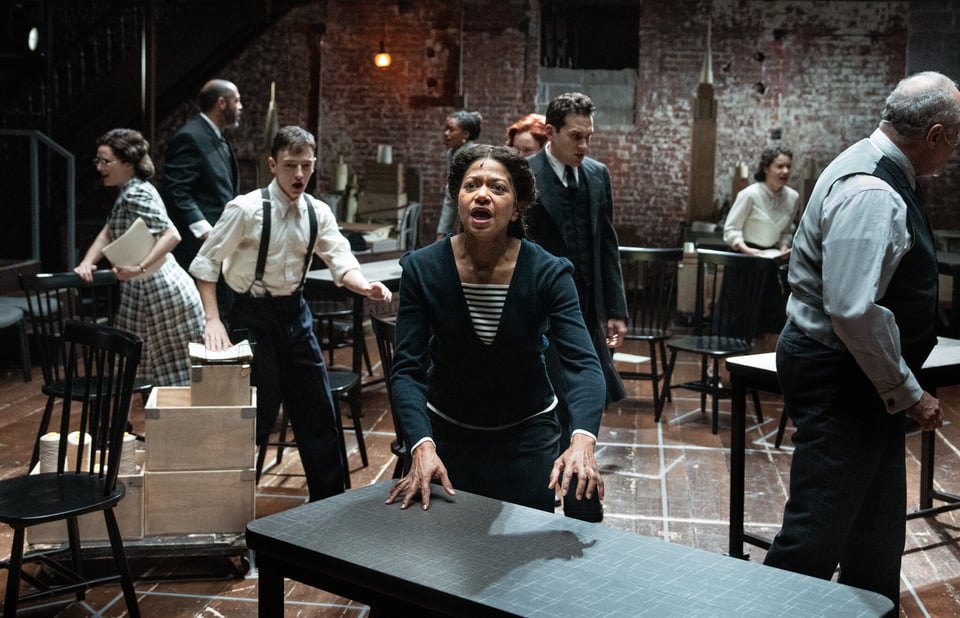
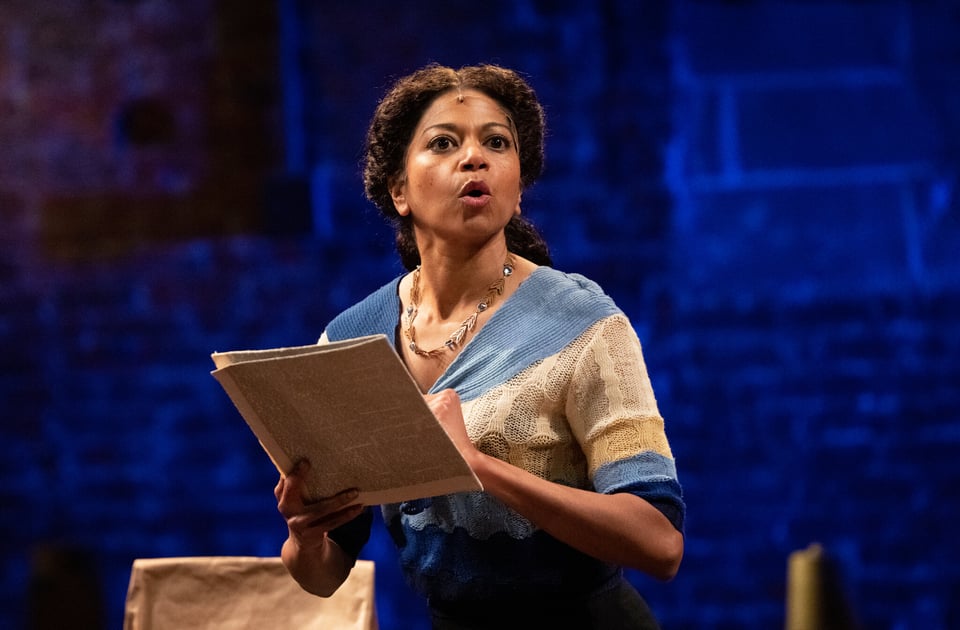
Rebecca Naomi Jones as Ruthie Rivkin and cast in this fall’s Off Broadway production of Jerome Weidman and Harold Rome’s “I Can Get It for You Wholesale” (1962), based on Weidman’s 1937 novel of the same name and updated by his son John Weidman, about Manhattan’s Jewish garment workers.
Perhaps it was the embedding — a kind of secret coding — that made it an influential yet ultimately unstable conversion, schismatic and contradictory. Strasberg would break away from Clurman, Clurman would marry and divorce Adler, Adler would disown Strasberg and start her own school; their friend Sanford Meisner would develop a splinter Method, and so would the fifth of the foundational figures, Bobby Lewis (né Lewkowitz). In whatever configurations, they and their colleagues, most of whom were likewise Jewish, trained and helped make stars of generations of students, most of whom were not. Adler begat Marlon Brando; Strasberg, James Dean; Meisner, Robert Duvall; Lewis, Meryl Streep.
Clurman most famously begat Clifford Odets, urging the young Group Theater actor to write plays, and directing one of his earliest — “Awake and Sing!” — in 1935. “Awake and Sing!” was among the first plays on Broadway (and for ages among the last) to deal frankly with poor Jewish characters, the kind that most of the cast, including Adler, Meisner and a 21-year-old who was born Jacob Garfinkle, but now called Jules Garfield, knew deeply because that’s what they were, too. Odets even gave them unreconstructed Jewish names. Adler, though only 34, played Bessie Berger, the matriarch of an impoverished Bronx family terrified of eviction. Meisner played Sam Feinschreiber, an immigrant boarder. And Garfield played Ralph Berger, Bessie’s idealistic son.
“Awake and Sing!” was a sensation and a breakthrough, proof of concept for the Group’s Americanized Method. Its title seemed to be, as well, an exhortation to proclaim Jewishness loudly as integral to the culture. But Broadway did not seriously take up the call, and Hollywood utterly ignored it. (“Awake and Sing!” wasn’t filmed until a version was made for television in 1972.) What the studios wanted was the talent, without their Jewish baggage. So when Jules Garfield quickly became a movie star, he did so under the name John. He soon joined Adler, who had gone to Hollywood earlier in 1937, changing her name to Ardler and getting a nose job.

Tovah Feldshuh as Golda Meir in William Gibson’s “Golda’s Balcony,” which premiered off Broadway in 2003.
NOBODY DAST BLAME them, either. Jews are not responsible for antisemitism, even the kind they internalize in trying to avoid the external kind. Adler and Garfield weighed the conflict between pride and practicality, between pronouncing their Jewishness and getting a job, and landed, as thousands of others did, on the side of paying the rent. That this clash of values and exigencies was in fact the theme of “Awake and Sing!” — in which Bessie forces her pregnant daughter into a loveless marriage with Feinschreiber — wouldn’t have been lost on them.
For Adler and so many others, Hollywood was the loveless marriage. Even with name and nose changes, most of the great Jewish stage stars of the era had middling film careers. The anticipated trade-off failed in an industry that, led by the Jewish studio heads, was paranoid, or perhaps just accurate and spineless, about American prejudice. William Fox, Louis B. Mayer, Jack Warner and the rest rarely made movies with juicy Jewish roles; when they did, they seemed to go to perverse lengths not to cast Jews in them. In “Marjorie Morningstar” (1958), about a Jewish woman who changes her name from Morgenstern to further her showbiz dreams, Marjorie is played by the Russian Orthodox Natalie Wood. And when “The Diary of Anne Frank” was made into a movie in 1959, an unknown non-Jew named Millie Perkins got the role, which Audrey Hepburn of all people had already declined. On Broadway four years earlier, the play had starred Susan Strasberg — Lee’s daughter.
At least on New York stages, to which Adler, reclaiming her name, returned around 1943, you might have expected the Method machine, as it churned out actors, playwrights and directors for decades, to give rise to an abundance of Jewish theatrical content. It didn’t.
Assimilation, easy or not, is never just a reaching toward something; it’s a turning away from something else. When the something you are turning away from includes poverty, parochialism and disdain, the urge to represent more than one’s own inheritance, or simply to bury it, may be even stronger. For many Jewish actors, especially in the wake of the Holocaust, it must have seemed safer to stake a claim in the larger world rather than the vulnerable little sector they happened to emerge from. And as artists their goal was surely to play Shakespeare and Ibsen in English, not just Sholom Aleichem in Yiddish.
Jews were neither the first nor certainly the last minority to anguish over that conflict between representing and transcending identity. Should Black actors, as a matter of pride, limit themselves to characters specifically written as Black? (The great Black playwright August Wilson thought so.) If gay or trans actors made analogous choices, they might not work at all.
That’s changing, slowly. But even as it does, the move to expand the canon, and to open the existing one to people formerly excluded from it, finds itself at odds with a movement to limit access to certain roles. The prohibition against blackface is being extended to more and more “faces.” As of now, those faces are asymmetrical: A Black actor can play a Jew — Adrian Lester played Emanuel Lehman — but not vice versa. There are inarguable political reasons for that asymmetry. Yet should we ever achieve a just society, will we require exact matches between playwright and story, actor and character, critic and production, production and audience, as if making theater were an organ transplant? And what would that mean for the many Black Jews and others whose mix of backgrounds doesn’t fit neatly into casting categories?
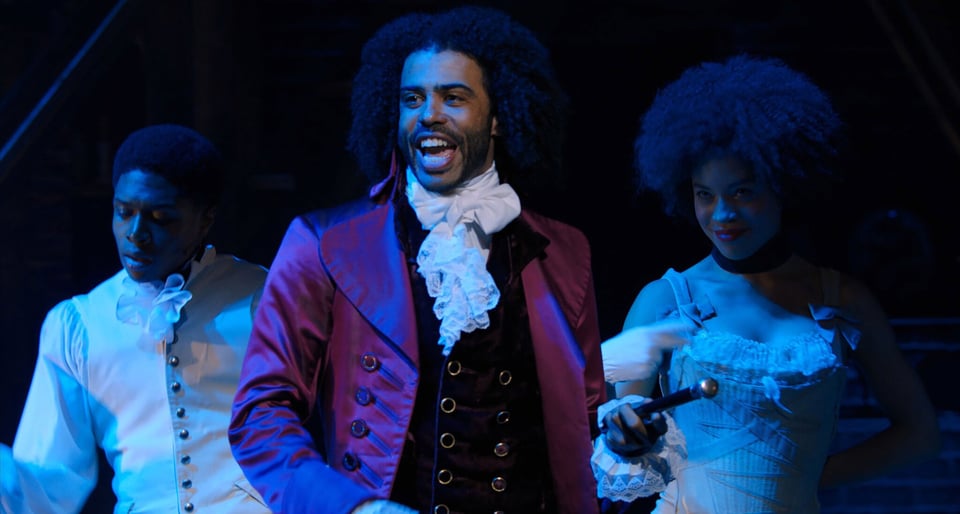
Daveed Diggs (center) in his breakout Broadway role as Thomas Jefferson in Lin-Manuel Miranda’s “Hamilton” (2015).


Barbra Streisand as Miss Marmelstein in “I Can Get It for You Wholesale,” her 1962 Broadway debut.
We are in what may be the opening years of an identitarian sea change, as various artists focus more overtly and exclusively on ever finer slices of themselves, speaking first to those in precise demographic alignment and only secondarily, if at all, to interested others. (As the chief theater critic for The New York Times, I have been asked not to review certain plays that creative teams apparently felt I, as a white man, could not appreciate.) This is the reverse angle on the ideal that Jews brought to the American stage. For one thing, Jews couldn’t afford to speak only to themselves as they moved uptown from Second Avenue: They may have made up a big part of the audience but only a tiny portion — 2.5 percent — of the U.S. population.
Beyond those commercial considerations are aesthetic and even spiritual ones. Strasberg’s version of the Method calls on actors to develop the habit of emotional recall so they can reach into the lives of characters who may at first seem unfamiliar but upon sympathetic examination reveal likenesses. Radical connectedness is the underlying message: We intersect everyone. This was a necessary skill for Jews (and other outsiders) even beyond the theater. (I am myself, but I am also you.) To confuse that with a rigid inhabitation of one’s own identity is to make a mistake like that of some actors who, misinterpreting the Method, over-inhabit the identity of their characters.
Well, whatever works. But the history of Jews in the American theater has largely been based on the necessity of opening up and looking beyond, instead of suffocating in, the small space of the self. Jewish playwrights have written from within other identities not only to avoid being pigeonholed but also to exercise the muscle of sympathy. Miller’s plays may not have featured many Jewish characters, but Jews in the audience knew how to hear between the lines of the Lomans or, for that matter, the Macbeths, just as Black people have long read themselves into white stories and gay people into straight ones. The details are merely grappling hooks that let us climb into the universal. In so doing, we learn to map the coordinates of our inner dramas against the ones onstage to approximate a fuller truth that neither alone is sufficient to reach. Without triangulation, the world is flat.
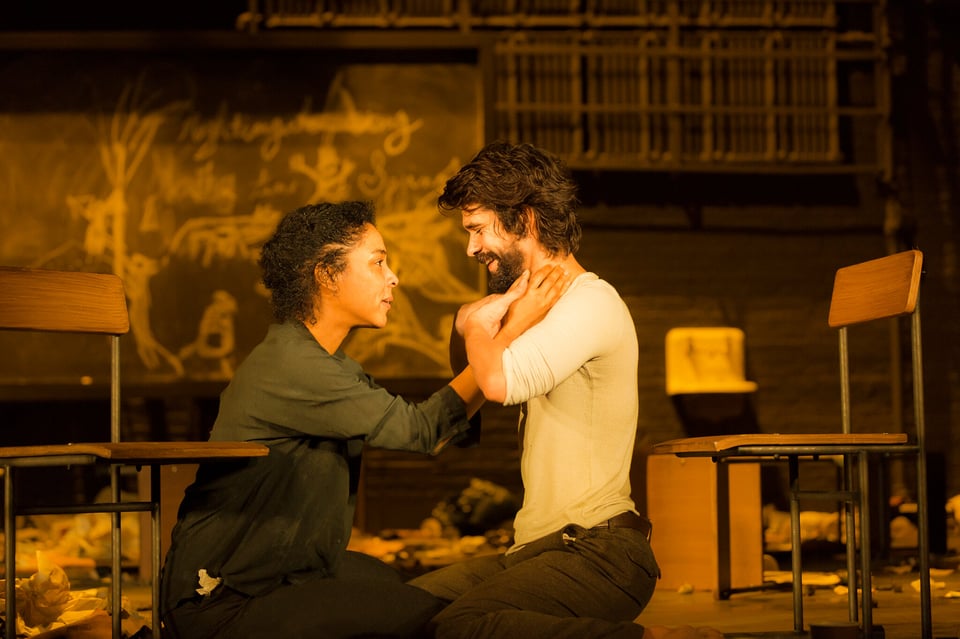
Sophie Okonedo (left) as Elizabeth Proctor with her co-star Ben Whishaw as John Proctor in the 2016 Broadway revival of Arthur Miller’s “The Crucible” (1953).
THAT’S OUR METHOD. Try to understand everyone. Keep quiet about ourselves. Don’t startle the gentiles.
I say “our,” but there are many kinds of Jews. “How Are Things in the Gemara?” would be no joke to some of them; my temple’s punchline is their holy text. I grew up in a different Jewish tradition, one that was slightly embarrassed about the old country and the old ways. (None of my immigrant grandparents ever wanted to see Eastern Europe again.) Though maintaining a pro forma adherence to Conservative Jewish ritual, we took the interstate to almost total assimilation via its service road, culture. Theater, often as not on Friday night, became our substitute orthodoxy: similarly argumentative, often musical and scholarly, if you were so inclined. I became a critic over whitefish salad.
But however airily we defined our Judaism — like many of us, I call myself a “cultural Jew,” with “cultural” doing at least double duty — we were haunted by the fear that others, when the time came, would omit the adjective and treat us accordingly. What, to the world, was a Jew anyway, having cut off his sidecurls and tossed his fur hat? Certainly not anything worthy of protection as a persistently endangered minority, or even worth seeing, having worked so hard to make himself invisible.
What awakened me to the reality behind that fear was, naturally, “Fiddler on the Roof,” which I saw during the Philadelphia stop of its first national tour, in 1969. I was 10. As the show’s Jews were forced, on three days’ notice, to pack up their belongings and leave their shtetl, I understood that this was more or less my grandparents’ story, the one they whispered about, or flipped into Yiddish, so as not to distress the kinder. Kitsch notwithstanding, I cried all the way home.
It wasn’t just their story that set me bawling. For me, “Fiddler” was a warning that the triumphs of American Jewry as I knew it — Bernstein! Miller! — could be knocked to pieces in no time. I’m sure Stoppard would be horrified to know that, for all its plush sophistication, what shook me at “Leopoldstadt” was precisely the same thing. His Viennese Jews are extremely cultured and yet extremely discreet. They are close with gentiles who share their love for painting, music, literature and, yes, theater (Schnitzler is a plot point) but, in the end, have few friends when the Nazis come knocking. Their lives are dismantled, in minutes not days, and most of them die in the Holocaust.

Jeanine Tesori and Tony Kushner’s “Caroline, or Change” (2004), which was revived on Broadway in 2021 and featured (from left) Sharon D Clarke in the title role and Adam Makké as Noah Gellman.
If “Leopoldstadt” stopped there, I wouldn’t have mixed feelings about it. But after the deportations it jumps to 1955, when Leo, a callow 24-year-old Brit much like young Stoppard — though Stoppard was born Czech, not Austrian — belatedly allows himself to learn the truth of what happened to most of his family. The play ends with a list of the death camps and the relatives who died in them or otherwise in the wake of the Anschluss. Each name is a cudgel pulverizing Leo’s blithe assimilation until he and most of the audience (the show was a hit) are a pile of rubble: “Hermine. Auschwitz. Heini. Auschwitz.” How dare a Jew not center historical trauma at all times!
To its portrait of the perils of complacency, this final scene thus adds a portrait of the egotism of survival. In each case the Jews are somehow to blame. Both the murdered Viennese and the living Stoppard stand-in apparently should have known better. Nor is that perverse idea confined to “Leopoldstadt.” Assimilation is not merely a danger but a moral failing in most contemporary theatrical portraits of Jews. The Lehmans lose their empire as they lose their religion. Ruth Wolff, in “The Doctor,” finds that being a cultural Jew offers her no protection from anti-Semites. (She, not they, is the author of her downfall.) On the other hand, in “Parade,” Leo Frank is carefully established as a hubristic outsider not only to Atlanta’s gentiles but also to its gracious, Southern-fried Jews. If only he’d been more likable! There’s no winning in these plays — but to be fair, there’s no winning in most plays. That’s what makes them plays.

Matthew Broderick (center) as Eugene Jerome in Neil Simon’s “Brighton Beach Memoirs,” which opened on Broadway in 1983.
Still, it does seem especially glaring that Jews are unlikely to be Jewish onstage unless they are endangered — literally or, as in “The Doctor,” professionally. Perhaps it’s not surprising, then, that what felt like the fullest theatrical representation of Jewishness among the recent crop of Jewish shows was Edelman’s “Just for Us”: 85 minutes of stand-up about some ineffectual Queens bigots he dismisses as “Nerf Nazis.” The jokes are the delivery system for an ancient anxiety but also the mark of victory over it. (His visit leaves the Nerf Nazis in confused disarray.) So even though he provides his full name — David Yosef Shimon ben Elazar Reuven Alexander Halevi Edelman — for laughs, he is serious (as he told The Times) about exploring the place of Jews on the “spectrum of whiteness without having a conversation about victimhood.”
Comedy may be best placed to have that conversation — and certainly, from Woody Allen and Rivers on, comedians have been having it. A jokefest like “Spamalot,” first seen on Broadway in 2005 and revived this season, can say what others can’t: “You just don’t succeed on Broadway / if you don’t have any Jews.” That’s true offstage, anyway. But perhaps most troubling in the prevailing conversation about Jewishness in the theater is that it’s exclusively concerned with what happens onstage. In fussing over noses and casting, looking to preserve our place on the playbill, we are defending the wrong thing. What Jews need most in the theater today is an enhanced and reciprocal culture of allyship, one acknowledging that Jewish plays and Jewish success do not nullify centuries of monstrous mistreatment or disqualify us from the list of targeted minorities. Our art is safe; it’s we who are not.

A Hanukkah scene from the 2022 Off Broadway production of Joshua Harmon’s “Prayer for the French Republic,” which will open on Broadway in January.
The Jewish contribution to the creation of the American theater was built on the acknowledgment of a larger humanity alive within each of us, available to some, with natural empathy and rigorous training. Not perfectly so: Though the gentile members of the cast of “The Lehman Trilogy” were excellent, they didn’t sound very Jewish to a Jew. Likewise, in seeking to dramatize universal conflicts (racism, despotism, violence, pride) by passing them through the lens of specific exoticized cultures, the Jewish gods of the golden age of the American musical — George Gershwin, Jerome Kern and Richard Rodgers among them — often sacrificed accuracy and sensitivity to power and gorgeousness. See: “Porgy and Bess” (1935), “Show Boat” (1927) and “The King and I” (1951). The Irish no doubt resent the leprechaun in “Finian’s Rainbow,” too, and the Scots the heather in “Brigadoon.”
But surely this doesn’t mean we should discourage artists from attempting the greatest thing theater can do: to create liminal spaces that allow us to cross over into new understandings of otherness. Of all people, Jews should recognize the necessity of that. After all, the American theatrical canon — starting in the 1920s for musicals and the 1960s for plays — is disproportionately the work of our tiny minority. For the decades in which the theater remained an important cultural catalyst, “American” and “Jewish” were thus nearly synonymous, not just on Broadway but also in high school dramatic clubs and community Melody Barns. Of course, some of that was because Jews were the gatekeepers, but it was a gate that swung both ways. Jewishness had to become American surreptitiously or by mere osmosis.
Having thrived on the practice, even when erring, we should now treasure it in others and let them err, too. If in some new golden age of theater we want anyone to play everyone — that’s certainly my dream — we have to begin to be happy with it now. For me, the best thing about last year’s Broadway revival of “Death of a Salesman,” starring Wendell Pierce, wasn’t that it had been finally made Jewish — it hadn’t — but that it had been finally made Black.
If that’s erasure, it’s a complicated, uplifting kind, consistent with Jewish values and habits and the history of Jews in the theater. Why else did Strasberg and Adler and the others create the Method but to open American culture to a people and a vision it had not yet fully welcomed? That their effort proved more influential than they dreamed, teaching the world how to act and creating a new kind of drama to act in, is not a mark of its failure but its success. We can celebrate that success in the names of Broadway theaters: the Friedman, the Jacobs, the Schoenfeld, the Hirschfeld, the Gershwin, the Simon, the Rodgers, the Sondheim. But having given so much to the world, we should let the world take it. And not to worry, we won’t disappear in the process. Brigadoon will still be a shtetl when it wakes up another hundred years hence, and “Glocca Morra” will always be Jewish when you sing it. (By Jesse Green, New York Times).
______________________________